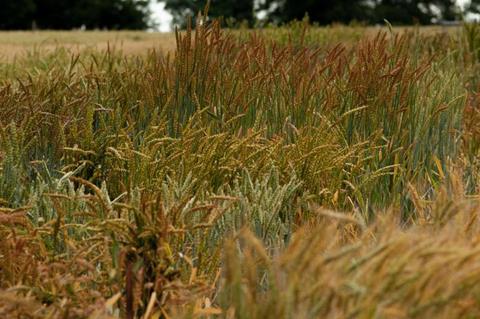An important breakthrough in efforts to halt the advance of wheat blast, an emerging threat to international food security, has come from a surprising source.

New research unexpectedly reveals that wheat varieties with resistance to another pathogen, powdery mildew, also confer protection against wheat blast.
When seeking resistance to diseases it is common to search among varieties or old landraces from regions where the disease originated. As wheat blast is a disease of humid sub-tropical regions, efforts to control the disease have focused on finding resistance genes among wheat varieties adapted to warmer climates.
But a research collaboration led by the John Innes Centre, and including the University of Zürich, challenges this approach, suggesting that researchers should not ignore resistance in wheat varieties that have been bred to withstand other diseases including those of colder climes, like powdery mildew.
Protective gene
Using gene discovery methods developed at the John Innes Centre, they have identified the first gene that protects wheat plants against the strains of the blast fungus that contain the protein effector AVR-Rmg8.
Surprisingly, the gene, located on chromosome 2A of the wheat genome, is Pm4, a gene that gives wheat resistance to powdery mildew, a disease of the cooler, wetter climates of the northern hemisphere.
European plant breeders have been selecting wheat with Pm4 for many years for resistance to powdery mildew; now those in the southern hemisphere will be urged to do the same as protection against wheat blast.
Unusual places
“These findings were completely unexpected, and they suggest that if you want to find resistance to wheat blast you should also look in varieties that come from non-tropical regions, where they already have resistance to mildew,” said Professor Paul Nicholson, a group leader at the John Innes Centre and coordinator of the study, which also includes contributions from Mexico-based CIMMYT and Saudi Arabia-based KAUST.
“We need to be open to the idea of looking in unusual places because blast is a disease of high temperature, high humidity environments while mildew is a disease of low temperature high humidity environments so no one would have thought of looking in European varieties previously because one is looking for commonalities.”
The research team made the discovery by screening more than 300 varieties of wheat in the Watkins Collection, a diversity panel gathered from around the globe in the 1930s. Out of this population, just three percent showed resistance to wheat blast pathogen strains that produce AVR-Rmg8.
Additional resistances
Worryingly, all the varieties that were highly resistant to blast carried the Pm4 gene, indicating that only a single resistance was present among this highly diverse population. This emphasises the need to identify additional resistances to ensure robust, durable resistance against this new threat.
The team will now use the same gene discovery methods to search among European-bred wheat varieties for further resistance genes to blast, increasing the genetic armory which can be deployed against this destructive disease.
Dr Tom O’Hara, lead author of the study, said: “This is the first cloned blast resistance gene – unlike previous resistances to blast we have gotten down to the exact gene – even identifying minute variations of the gene that render it nonfunctional. This means our findings can be of great immediate benefit for breeders.
“Our aim from the start was to find resistance that was deployable in Bangladesh and potentially other countries where blast has spread to. The added satisfaction is that our study has taken an unexpected twist.”
The wheat powdery mildew resistance gene Pm4 also confers resistance to wheat blast appears in Nature Plants.
Emerging threat of wheat blast
Almost all cereal diseases have existed for thousands of years and the pathogens causing them have co-evolved with their hosts. Wheat blast, by contrast, is an extremely new disease, first emerging in 1985 in Brazil, and so there has been no time for the host to adapt to this new threat.
Following its appearance, wheat blast spread throughout South America in humid tropical climates.
In 2016 wheat blast was reported in Bangladesh and in 2018 was identified in Zambia. In both instances it appears that the disease has been imported on grain from South America.
Fortunately, the strain(s) causing outbreaks of wheat blast outside Brazil all produce a small protein effector called AVR-Rmg8. This molecule is part of the machinery used by the fungus to suppress wheat defences. The presence of this protein, however, is a potential ‘Achille’s heel’ if the wheat variety can detect this protein and initiate its defence responses.







No comments yet